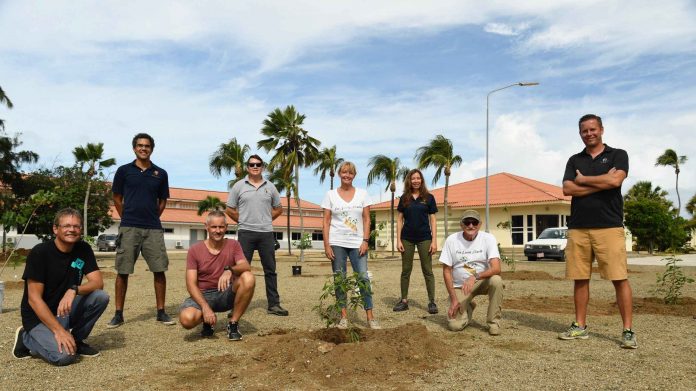Ban Lanta y Planta, Stimaruba, Fundacion Parke Nacional Aruba, the University of Aruba and the Savaneta Marine Barracks proudly announce their special collaboration for planting local trees to restore and improve Aruba’s natural environment.
The kick-off of this unique collaboration for Aruba took place from 27 to 29 November 2020 at three different locations: the University of Aruba, the Savaneta Marine Barracks and the Parke Nacional Arikok. The first part consisted of the planting of the very rare and protected Palisia Cora (Bursera simaruba), at all three sites, which significantly increases the distribution of this species. Additionally, at the Savaneta Marine Barracks, some 50 trees and shrubs of 18 different species of locally endangered trees were planted on a large site, ‘Park Van Dasselaar’, which has guaranteed optimal protection and a potentially high success rate for the growth and development of the trees.
Trees provide numerous important and essential – often also medicinal – functions. They provide oxygen to the environment and improve air quality. Trees bring shade and make for more pleasant ambient temperatures and reduce the ‘heat island effect’ caused by roads, sidewalks and buildings. Trees line our streets, and are found in our parks, playgrounds, front and back gardens, and create a quiet, aesthetic and attractive environment in many neighborhoods. In many countries, very old trees are a historical landmark and a source of national pride due to their beauty and majestic appearance. Trees also help fight climate change by absorbing large amounts of carbon dioxide.
There are 352 species of plants and trees registered on the island, of which 6 species only occur on Aruba. Many species are under pressure and threatened in their survival. Replanting native trees is essential for restoring the original tropical forest, restoring a healthy soil structure, creating more habitats for local wildlife, and increasing Aruba’s biodiversity. But perhaps even more important than replanting native trees is the preservation and protection of the already existing trees, as the older a tree is, the greater its ‘ecosystem service’ and its contribution to human health.
By working together, the five organizations share their knowledge and bundle their expertise in protecting and preserving the still-existing nature, rehabilitating and restoring the original nature that has been affected by human activities over the centuries, reaching out to the local community with the aim of increasing the appreciation for local flora, and joining in the efforts to conserving Aruba’s biodiversity and achieving a sustainable future.
In 2021, the five organizations jointly aim to realize:
– Growing local trees in nurseries for the purpose of reforestation
– The annual organization of two joint tree planting events
– Raising awareness through social media
– Promoting gardening with local plants and trees
– Promoting nature-friendly and sustainable gardening
– Providing educational opportunities through lectures and presentations
The organizations look back on a fruitful kick-off weekend and look forward to further strengthening their collaboration and fortifying their efforts with the help of the community and volunteers. The organizations will continue to focus on promoting and planting local trees for the benefit of Aruba’s natural environment and biodiversity.
Beyond the collaboration, each organization makes its own specific contribution to the conservation of local flora, increasing biodiversity and promoting sustainable behavior:
Ban Lanta y Planta (Trees for Aruba)
Ban Lanta y Planta is a young foundation that is working hard to achieve their first goal of growing and planting 10,000 native trees, including mangrove. This non-governmental, voluntary organization also actively focuses on education and community outreach to create awareness for the protection of existing trees and their importance.
Stimaruba
Stimaruba is one of the oldest NGOs on the island dedicated to nature protection and nature conservation, with a strong focus on local flora and education. Stimaruba has mapped flora throughout the island and organized hundreds of tours to increase knowledge about the importance and medicinal uses of local and endangered plants and trees.
Fundacion Parke Nacional Aruba (FPNA)
FPNA is a professional NGO dedicated to the conservation and the management of 16 terrestrial nature reserves and 4 marine protected areas. FPNA’s work includes various species protection programs, the restoration of numerous natural habitats, the conservation of flora through their botanic gardens system, and the creation of awareness for healthy and resilient ecosystems and sustainable behaviors.
University of Aruba (UA)
The UA’s newly developed SISSTEM program will be making significant contributions to nature conservation and environmental protection through student research and the development of a biodiversity app that will help map and monitor local and protected tree species in specific locations. The UA campus supports local biodiversity with their planting scheme of native trees and plants.
Savaneta Marine Barracks (MSK-SAV)
The MSK-SAV is a role model with its strong focus and ambition of integrating sustainability into their daily operations, including allocating large areas of the barracks for rewilding with hardy, heat- and drought-resistant, local trees and plants. MSK-SAV directly contributes to increasing biodiversity, including conserving and protecting the endemic and endangered Aruban burrowing owls that breed at the barracks.




















